


October starts the third quarter of the Japanese fiscal year and many of our core activities will take place during the next three months. These include the 2011 Japan Foundation Invitational Group-Tour Program for Educators in North America, BUDO: United States Martial Arts Festival 2011, the ACTFL Conference, application deadlines for our Japanese-language Programs, and the Japanese-language Proficiency Test. We have also supported many projects during the month of September and reached a major milestone in the completion of 2011 JLPT registration. I hope you will take a moment from your busy day to read about all of our activities, and come out to support us at one of our future events.
Misako Ito, Director

The Japan Foundation, Los Angeles, and The United States Martial Arts Committee present the "United States Martial Arts Festival 2011" with the support of the Japanese American Culture and Community Center at the Redondo Beach Performing Arts Center on Saturday, November 5th, 2011. This event will feature an admission free area showcasing Japanese Art forms such as SADO: Japanese Tea Ceremony, KADO: Japanese Flower Arrangement, and SHODO: Japanese Calligraphy. There will also be a ticketed area with 16 martial arts performances, divided up into two sessions, organized by the Shin Koyamada Foundation and a panel discussion organized by JFLA. For tickets, please visit All American Tickets later this month.

This month, we have invited Yumi Furumoto, a teaching assistant at Dobson High School in Arizona and Shuhei Hokonohara at Taylor Allderdice High School in Pennsylvania to share their experiences as teaching assistants at American high schools. As you may recall, we sent 15 Japanese teaching assistants to assist Japanese-language teachers at select high schools all over the country. Each month, two participants will report on their experiences.
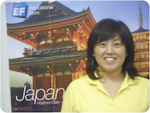
Hello, my name is Yumi Furumoto and I am from Hiroshima, which is in the western part of Japan. It has been one month since I arrived here in Arizona and I discovered that it is very hot here. So hot that I often see students resting in the shade under a tree during break, which was an initial interest for me. The sky is so broad here with the sun so strong and deadly yet so very beautiful at the same time.
Dobson High School has become my new home where I assist the Japanese teacher as a teaching assistant. There are 4 Japanese classes at this high school with about 60 students studying Japanese. I have been helping some of the students who can’t keep up with the class and I recently started tutoring a student who needed help remembering Katakana. We studied together for 30 minutes every day and I liked her attitude because she never gave up. Moreover she had a rich imagination and often tried to remember Katakana by associating it with pictures and English words. Connecting words and characters by concept is more useful than simply memorizing them. Students can also remember them more deeply and longer. I encouraged her during our tutoring sessions by asking these three questions:
1) When you forgot the Katakana, what should you do? (Ex. Check my Katakana packet.)
2) Which Katakana do you make the most mistakes with? And why? (Ex. It’sシ. Because there is ス in the same サ line and シ sounds like ス. And it is more difficult to remember the middle letters (イ, ウ and エ) in the ア line than the first and last (ア and オ).)
3) How should you distinguish the indistinguishable Katakana? (Ex. サandシis three strokes. ス, セ and ソis two strokes. In the サline, three strokes come before two strokes.)
One day, she said “My Katakana is improving.” I was very glad to hear her enthusiasm.
One of my goals as a teaching assistant is to encourage students who are interested in foreign countries and help them learn foreign language. I also hope to see various ways of teaching Japanese while brushing up my own teaching skills. I will be going to other schools in the community to share my knowledge of Japanese language and culture. And someday I hope to be able to share my experiences with students in Japan.
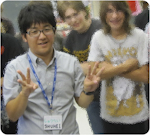 Shuhei Hokonohara (Taylor Allderdice High School)
Shuhei Hokonohara (Taylor Allderdice High School)Two months have passed since I came to Pittsburgh, Pennsylvania and I am getting used to my new life here and having some fun too. I was sent to Taylor Allderdice High School, which is a public high school in the city of Pittsburgh. There are five foreign language courses including Spanish, French, German, Chinese and Japanese. I teach four Japanese classes as an assistant, two classes for level 1, one for level 2 and one upper level class (levels 3, 4, 5).
Level 1 is a beginner class with a diverse group of student who are motivated to learn Japanese. At first, they studied some expressions, such as introductions, greetings, numbers, and then they did simple role plays to experience speaking Japanese. Then, they studied hiragana. Even though they are so excited to study hiragana, it was not easy for them, so we provide them with some hands-on activities. For example, each student has a mini white board and writes hiragana on the board after the teacher calls, and then they share it with everyone in class. This way, they can study Japanese in an enjoyable format.
Level 2 is for students who have learned hiragana, katakana, some kanji characters and basic expressions. In this class, we deal with various topics including “weather”, “food”, “family”, “daily routine” and so on. By the end of year, the students in this class will be able to speak about themselves and communicate with other students in simple Japanese.
The upper level class has three different levels of students and sometimes it is difficult to develop activities for all of them, so we tried to differentiate the instruction. By pairing students of different levels we can promote interaction between them so they can help each other learn.
I have also introduced Japanese culture in class, for example, I talked about “Otsukimi (moon viewing)” and “Shuubun-no-hi (autumn equinox day)” in September, and I also showed them some picture my family sent, which they were very happy to see.
Since it is not easy for them to experience Japanese culture in the U.S., I am determined to give them as many opportunities to experience Japanese culture as I can, such as cooking Japanese food, singing Japanese songs, and watching Japanese drama/anime.
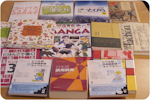
This month, we have some new books in the Nihongo Library, which are listed below. If you are a general member, you can visit our library Monday through Friday, from 10AM to 5PM (Except Holidays), to check these out. For mail-circulation members, you can search for these books along with all our other print and audiovisual materials through our new online catalog.

This is the second part of an eight part series that will highlight the experiences of 32 participants of the 2011 JET Memorial Invitational Program. Through this program, participants travelled to Japan in July of 2011 for a 10 day exchange that focused on Japanese language and culture with the purpose of fostering friendship and goodwill between the youth of both countries. This month, we will be featuring the essays of Valerie Holland, Matthew Lum, Jason Mitchell and Alex Kessler.
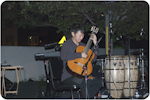
September marks the six month anniversary of the March 11 earthquake and tsunami that devastated the northeastern coast of Japan. To mark this anniversary and to express thanks to all the individuals and organizations who participated in earthquake relief and fund raising, the Consulate General of Japan in Los Angeles organized the ARIGATO Event at JACCC's Noguchi Plaza on September 7th. JFLA supported this event by inviting Soichi Muraji, a well known guitar player from Japan who now resides and performs in the United States. During the event he played the song "Wings to Fly," which is a favorite among the people of Japan. We would like to thank everyone who came out to this event and hope you will continue to support Japan.
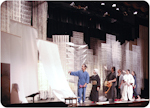
Recycling: Washi Tales brings to life through performance, the human stories contained in sheets of handmade Japanese paper (washi). In Japan, authentic beauty is found in the old, and washi is made when existing paper is disassembled, beaten into pulp, and stretched anew on bamboo frames. This event features a conversation between paper artist Ibe Kyoko and curator of Japanese Art Hollis Goodall followed followed by a performance Recycling: Washi Tales. In the performance, a papermaker cradles old documents in her hands. As she creates new undulating sheets onstage from these records of history, four narratives emerge: life in a 19th-century village, a tragic betrayal for a young wife, the austere elegance of the tea ceremony, and a loss transformed into everlasting life. An extraordinary ensemble of performers and musicians, including 15th generation Noh drummer, Shonosuke Okura, Biwa player Shisui Arai, vocalist Makiko Sakurai, performer Karen Kandel, and actor Sonoko Soeda, in a world created by distinguished paper artist, Kyoko Ibe. This event is held in conjunction with the installation, Washi Tales: The Paper Art of Ibe Kyoko, on view September 1 through November 28, 2011 at the Los Angeles County Museum of Arts with the support of JFLA.

September marked another month of growth for our office with the addition of Bethany Grenald and Maiko Ota Muranaka. Bethany helped us out during the latter half of JLPT registration in September and will continue to assist us with various special projects. She previously lived in Japan and received a Japan Foundation grant to research Women Divers of Japan for her dissertation. Maiko has worked for us in the past as an intern and will be helping us again in our library as well as with various tasks in the office. We are very happy to have them on board as we continue to take on more and more projects.
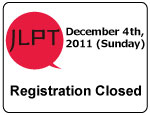
The application period of the 2011 JLPT closed on Friday, September 30th, 2011. Everyone who sent in their application by the deadline should have received an email confirmation. We will be sending out Vouchers and Vital Information Sheets in Mid-November via USPS first class mail, so please watch out for those. There are less than two months remaining before the big day so we hope everyone registered will study hard to pass the test.

Shonen Knife have been the most internationally recognized name in Japanese Rock music since their entrance onto the alternative rock scene in the early 90s when them became the indie darlings of hipsters and rock stars alike. Since their inception in Osaka in 1981 (featuring Naoko's sister Atsuko and their friend, bassist/vocalist Michie), to their current lineup featuring members Ritsuko (bass, vocals) and Emi (drums,vocals), Shonen Knife have maintained their rightful place in the ever changing indie rock scene. With the support of the Japan Foundation, Shonen Knife will be touring all across the United States with performances at various cities across the West Coast. For more information, please visit their website below.